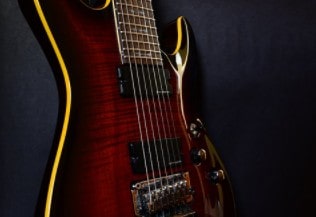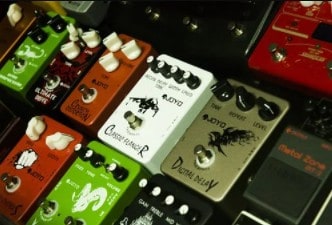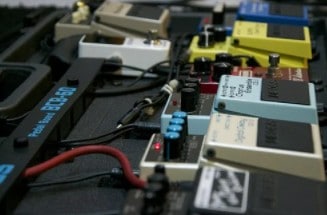Do you want your guitar playing to sound better? Are you looking to create that perfect tone only achievable in your dreams?
If this is the case, read on.
Because, in this article, you'll learn about guitar effect pedals and how guitar pedals work.
Before I started using guitar pedals, the tone from my guitar was dry and boring, and playing live wasn't much better.
When I learned about guitar pedals, my life changed. I found that there was more to explore with sounds and new music.
Since then, I've had a ton of fun exploring all the effects out there and experimenting with them, and my sound has improved immensely.
What is a guitar effect pedal?

A guitar effect pedal is an electronic device that alters how a guitar sounds. Some common examples of the type of effects pedals include overdrive, distortion, delay, and reverb effects.
You can use guitar pedals to control parameters such as volume and tone.
Musicians use guitar pedals widely in genres like blues and rock music and even in contemporary pop and hip-hop.
Guitar pedals expand your sound and allow you to create music that is more diverse.
These pedals are designed for use with electric guitars but may also be used with acoustic guitars and other stringed instruments, such as mandolin and ukulele.
Guitarists control pedals using a foot-operated unit, such as a floor pedal or knee pedal. There are also types of pedals that are controlled by hand using knobs or switches on the pedal.
Types of guitar effects

There are several types of effects.
We have categorized them according to the way the effect works.
Filters
Filter effects use a filter to control the sound. They work by eliminating some frequencies from the sound. The effect is most prominent on instruments with harmonic content, such as guitars and organs.
Examples of filters include wah-wah, equalizer, fuzz pedal boxes, and talkbox.
Compressors
Compressors help control the dynamic range of an instrument.
For example, you can use a compressor to make soft notes louder and loud notes softer.
Compressors are mainly used with electric guitars.
Dynamic pedals include compressors, limiters, and noise gates. They make guitars sound quieter or louder.

Gain effects
Gain effects create distortion, fuzz, or overdrive in the signal. This effect is most commonly used on electric guitar but may also be used on other stringed instruments such as bass and banjo.
Other examples of gain pedals are preamp pedals and boost pedals.
Pitch effects
Pitch effects alter the pitch of an incoming sound. This includes octave dividers and harmonizers such as the Eventide PitchFactor.
The effect works by altering the frequency content in a pre-defined way. Others are a Tuner, Pitchshifter, Octaver, and Octave Fuzz.
Modulation effects
Modulation effects change the tonal color of incoming sound. The most common types are chorus, flanger, and phaser.
Vibrato is also considered a modulation effect.
Examples of modulation pedals include envelope followers, auto wahs, leslie speakers, phase shifters, ring modulation effects, and univibe.
Volume effects
Volume effects are used to control the volume level of an instrument. They include tremolo, volume, and envelope effects.
Time-based effects
Time-based effects are used to change the timing of an instrument, often increasing or decreasing the delay time.
They include chorus, flanger, analog delay, and digital delay pedals.
Examples also include reverb, looper, and echos.
Multi effects pedals
A multi-effects pedal is a single pedal that includes several types of guitar effects.
Multi effects are the most common type of guitar pedals. They allow you to change one effect without having to adjust any other parameters on the pedal.
They include distortion, modulation, and volume/gain controls. Most multi-effect pedals have a built-in tuner, which makes it easy for you to tune your guitar. The most common one is the Line 6 Helix
Utility pedals
Utility pedals or utility effects are like multi-effects pedals but with a single function, such as volume control. They can be used in any type of music. Examples of utility effects include distortion, volume, and wah/filter controls.
How do guitar pedals work?

In a nutshell, a guitar pedal adds an effect to the guitar sound. How they work depends solely on the effects they are designed to produce.
There are several types of pedals.
The popular ones include chorus pedal and flanger pedal and less common effects like overdrive pedal and phase shifter pedal.
Different pedals will give different results on the guitar sound.
Other factors that determine how a pedal work include:
- ON and OFF
- Inputs and Outputs
- True bypass and buffered bypass
- Analog vs. digital
- Controls
- Power options
- Signal flow
FAQS on guitar pedals
The answer is no. Pedals are more like an accessory, not a requirement. Most products will work fine without pedals.
Using them in place of effects built into your amp can give you many extra sound quality and variety options. However, they will not make you better or worse at playing guitar.
Therefore, you should learn to play guitar as a beginner first before investing in pedals.
Yes. The power supply for guitar pedals is different than the one used on effects built into amplifiers. Guitar pedals run on batteries, and you will get a shorter playing time if you use batteries instead of an adapter. You must also keep in mind that no batteries can power all guitar pedals.
Yes, you can use specific pedals that are meant to be used with an acoustic guitar. Some pedals work with both electric and acoustic guitars.
There are many types of guitar pedals on the market. When you buy one, you need to think about what type of music they are for, how you play your guitar, and what effect you're trying to replicate.
Wrap up
I hope you found this article helpful. Now you know what guitar pedals are and how they work.
Guitar pedals are used to add effects to your guitar. They help you replicate several effects like reverb, deal fuzz distortion, and so forth.
How a pedal works depends on which of these effects you're trying to replicate. Before buying a guitar pedal, think about what sound effects you want. Then get the pedal that is right for your style.

